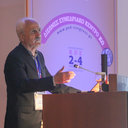Severe iron deficiency anemia and anasarca edema due to excessive cow`s milk intake.
Palavras-chave
Resumo
Mantadakis E, Zikidou P, Tsouvala E, Thomaidis S, Chatzimichael A. Severe iron deficiency anemia and anasarca edema due to excessive cow`s milk intake. Turk J Pediatr 2019; 61: 102-106. The authors describe a 13-month-old girl who presented with progressively worsening anasarca edema that developed over the last three weeks along with increasing fatigue. Over the last several months she was consuming progressively increasing amounts of fresh cow`s milk. Laboratory examinations on admission showed severe microcytic and hypochromic anemia (hemoglobin 3.8 g/dl) and hypoferritenemia indicative of iron deficiency, while urinalyses showed no proteinuria. The child was transfused with 13ml/kg packed red blood cells and approximately 2g/kg intravenous albumin. On the second and fourth hospital days, she received 100 mg of iron sucrose intravenously that she tolerated well. Eight months after the described events, she is healthy with normal hemoglobin for age, while she has no laboratory evidence of cow`s milk protein allergy. Pediatricians should be aware of the association of severe iron deficiency anemia (IDA) and anasarca edema, and should screen infants in their practice for anemia at the age of 12 months or sooner, if risk factors are present.



